



Table of Contents
- Introduction to Delhi-Meerut RRTS
- Delhi-Meerut RRTS: Project Journey
- Delhi-Meerut RRTS: Route
- Delhi-Meerut RRTS: Map
- Delhi-Meerut RRTS: Stations
- Delhi-Meerut RRTS: Fare Structure
- Delhi-Meerut RRTS: Features
- Delhi-Meerut RRTS: Facilities & Amenities
- Delhi-Meerut RRTS: Ridership Details
- Delhi-Meerut RRTS: Integration with Delhi Metro and Meerut Metro
- Delhi-Meerut RRTS: Expansion Plan Overview
- How NCR's Transit System Took Shape
- Conclusion
- Faq's
Introduction to Delhi-Meerut RRTS
The Delhi-Meerut Regional Rapid Transit System (Delhi-Meerut RRTS) represents a transformative transportation initiative, anchoring a vital 82.15 km (51.05 mi) corridor that will seamlessly connect key cities within the National Capital Region (NCR) of India, namely Delhi, Ghaziabad, and Meerut. This visionary project is a cornerstone of the RapidX program's first phase, overseen by the National Capital Region Transport Corporation (NCRTC), aimed at revolutionizing regional transit infrastructure.
Distinguished by its semi-high-speed rail capabilities, the Delhi-Meerut RRTS is designed to accommodate speeds of up to 180 km/h (110 mph), ensuring swift and efficient travel across the corridor. Once fully operational, commuters can traverse the distance between Delhi and Meerut in under 60 minutes, a remarkable improvement in connectivity and accessibility for residents and visitors alike.
At the heart of this ambitious endeavor are 16 strategically located stations, each designed to integrate seamlessly into the urban fabric while providing convenient access points to key destinations and transportation hubs. The journey commences at the Jangpura station, setting the stage for a streamlined travel experience that traverses significant centers such as Sarai Kale Khan, which serves as the pivotal terminal for three planned corridors within Delhi.
Moreover, the Delhi-Meerut RRTS is not just a transportation artery but a catalyst for economic growth and sustainable development. With an investment of ₹30,274 crore (US$3.8 billion), this project underscores a commitment to modernizing transit infrastructure while fostering job creation, enhancing connectivity, and reducing environmental impact through efficient, mass transit solutions.
Crucially, the system's comprehensive design includes two depots situated at Duhai and Modipuram, ensuring operational efficiency, maintenance capabilities, and a robust foundation for future expansions and enhancements.
The Delhi-Meerut RRTS heralds a new era in regional connectivity, blending cutting-edge technology with a strategic vision for sustainable and inclusive growth across the National Capital Region.
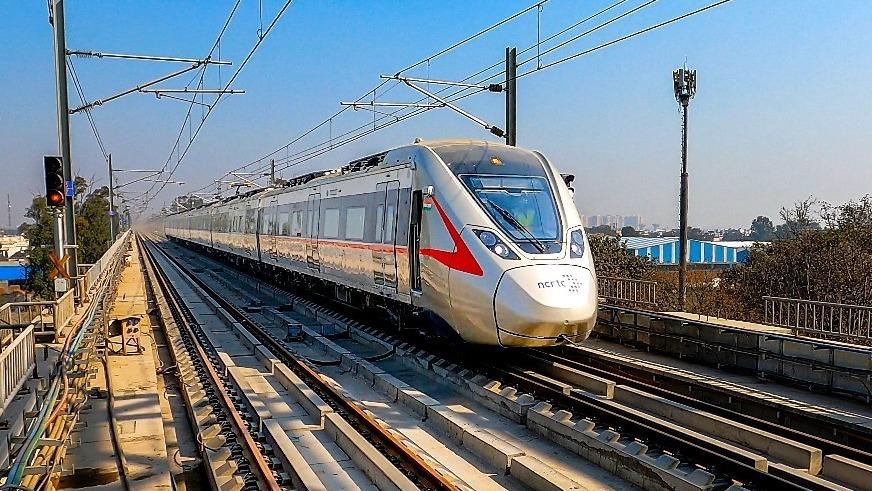 Delhi-Meerut RRTS
Delhi-Meerut RRTS
Image Source: Wikipedia
Delhi-Meerut RRTS: Project Journey
The Delhi-Meerut RRTS project's journey from conception to its ongoing implementation is a testament to India's commitment to modernizing its transportation infrastructure. Prime Minister Narendra Modi laid the project's foundation stone in March 2019, marking a significant milestone in the region's transit evolution. Construction swiftly followed in June 2019, heralding the beginning of a transformative endeavor.
The initial phase of the project focused on creating a 17 km (11 mi) priority corridor stretching from Sahibabad to Duhai Depot, slated for operational readiness by March 2023. However, due to necessary work, particularly in stations like Ghaziabad, the timeline experienced delays. Despite these challenges, the project's inauguration by Prime Minister Modi on 20 October 2023 marked a significant achievement. The subsequent goal of opening the entire 82 km (51 mi) corridor by June 2025 remains a beacon of progress and connectivity for the region.
Noteworthy advancements include the extension of the corridor to Modinagar North from Duhai Depot on 6 March 2024, expanding operational coverage to approximately 34 km (21 mi). This incremental growth underscores the project's dynamic nature and its adaptability to evolving transit needs.
Ownership and operational responsibilities are well-defined within the project framework. The National Capital Region Transport Corporation (NCRTC) assumes ownership, overseeing construction endeavors. Meanwhile, operational duties fall under DB RRTS Operations India Pvt. Ltd., a subsidiary of Deutsche Bahn (DB). This strategic partnership combines global expertise with local knowledge, ensuring a seamless and efficient operational framework.
A significant achievement of the Delhi-Meerut RRTS is its status as India's first regional transit system, epitomizing speed and efficiency. The operational speed of 160 km/h (99 mph) positions it as the country's fastest rapid transit train, a testament to its technological prowess and commitment to providing world-class transportation solutions.
|
Aspect |
Details |
|
Project Name |
Delhi-Meerut Regional Rapid Transit System (Delhi-Meerut RRTS) |
|
Project Type |
Semi-high-speed rail and regional transit corridor |
|
Total Length |
82.15 km (51.05 mi) |
|
Maximum Speed |
180 km/h (110 mph) |
|
Cost |
₹30,274 crore (US$3.8 billion) |
|
Commute Time (Delhi-Meerut) |
Less than 60 minutes |
|
Start and End Points |
Jangpura (Delhi) to Modipuram (Meerut) |
|
Number of Stations |
16 |
|
Depots |
Duhai and Modipuram |
|
Project Timeline |
|
|
Recent Extensions and Milestones |
Extension to Modinagar North from Duhai Depot: 6 March 2024 (34 km) |
|
Inauguration |
Inaugurated by Prime Minister Narendra Modi: 20 October 2023 |
|
Ownership |
National Capital Region Transport Corporation (NCRTC) |
|
Operator |
DB RRTS Operations India Pvt. Ltd. (a subsidiary of Deutsche Bahn) |
|
Notable Achievement |
|
Delhi-Meerut RRTS: Route
The Delhi-Meerut RRTS route is strategically designed to optimize efficiency and connectivity across the National Capital Region. Here are the key points about the route:
Route Characteristics:
- Elevated: 68.03 km (42.27 mi)
- Underground: 14.12 km (8.77 mi)
- At-grade: 1.45 km (0.90 mi) for depot connections at Duhai and Modipuram
- Dense Areas: Underground sections in densely populated areas of Delhi and Meerut, including near the Yamuna River at Anand Vihar
- Speed Specifications: Maximum speed of 180 km/h (110 mph) and operating speed of 160 km/h (100 mph), with an average speed of approximately 100 km/h (62 mph)
Starting and Ending Points:
- Starts from Jangpura and takes the main course from Sarai Kale Khan station, serving as the terminal station for all planned corridors in Sarai Kale Khan, Delhi
- Passes through Delhi, and Ghaziabad, and terminates at Modipuram in Meerut
Key Stations and Multi-Modal Hubs:
- Sarai Kale Khan Station: Largest station with three levels, six platforms, and six tracks, serving as a multi-modal transport hub connecting with Delhi Metro, ISBT, and Hazrat Nizamuddin railway station
- Anand Vihar Station: Acts as a multi-modal hub connecting with Anand Vihar Terminal railway station
- Ghaziabad Station: Another hub for interchanging with proposed corridors like Ghaziabad-Jewar, Ghaziabad-Khurja, and Ghaziabad-Hapur
Operational Status and Expansion:
- March 2024: Operational Sahibabad-Modinagar North section (34 km or 21 mi)
- January 2024: Upcoming operational section from Sahibabad to Meerut South (25 km or 16 mi)
- Expected by End of 2024: Operational section from Sarai Kale Khan to Sahibabad (16.60 km or 10.31 mi)
- Future Expansion: Addition of Jangpura as a starting station, increasing the number of stations to 16 from the initial plan of 14
|
Route Segment |
Length |
Characteristics |
|
Elevated Section |
68.03 km (42.27 mi) |
Majority of the route is elevated for efficient travel |
|
Underground Section |
14.12 km (8.77 mi) |
Underground passages in densely populated areas and near the Yamuna river at Anand Vihar |
|
At-Grade Section |
1.45 km (0.90 mi) |
At-grade portions for connections to depots at Duhai and Modipuram |
|
Maximum Speed |
180 km/h (110 mph) |
Designed for a maximum speed of 180 km/h |
|
Operating Speed |
160 km/h (100 mph) |
Operating speed of 160 km/h, ensuring swift and efficient travel |
|
Average Speed |
Approximately 100 km/h (62 mph) |
Average speed across the route, optimizing travel time |
Delhi-Meerut RRTS: Map
 Delhi-Meerut RRTS Map
Delhi-Meerut RRTS Map
Image Source: Wikipedia
Delhi-Meerut RRTS: Stations
The Delhi-Meerut RRTS corridor commences from Jangpura and follows its path through Sarai Kale Khan, both situated in Delhi. Continuing on, it traverses Ghaziabad, where three additional corridors to Jewar, Hapur, and Khurja are planned to connect nearby towns and cities in Uttar Pradesh with the National Capital Region (NCR). Simultaneously, it intersects with the Meerut Metro line as it crosses Meerut, culminating at Modipuram.
The corridor comprises a total of 16 stations. Among these, 9 serve as intermediate stations for the Meerut Metro, without stops for the RRTS. However, at four stations- Meerut South, Shatabdi Nagar, Begumpul, and Modipuram-both the RRTS and Meerut Metro will be integrated, facilitating passenger stops for both systems.
Currently, the corridor features 8 operational stations and one depot, with an additional 8 stations, the Meerut Metro integration, and another depot under construction. The stations' external designs are inspired by the vibrant feather colors of the Peacock, India's national bird.
Here's a list summarizing the stations, their integration with existing transport modes, and their current statuses:
- Jangpura (Starting Station) - Delhi
- Sarai Kale Khan - Delhi (Integration with Delhi Metro, ISBT, and railway station)
- Ghaziabad - Uttar Pradesh (Hub for interchanging with multiple corridors)
- Meerut South (Integrated station with Meerut Metro)
- Shatabdi Nagar (Integrated station with Meerut Metro)
- Begumpul (Integrated station with Meerut Metro)
- Modipuram (End Station, Integrated station with Meerut Metro)
- Other intermediate stations for Meerut Metro integration (9 stations)
- Depots: Duhai (Functional), Modipuram (Under construction)
This layout highlights the strategic locations, integration points, and construction statuses of the stations along the Delhi-Meerut RRTS corridor.
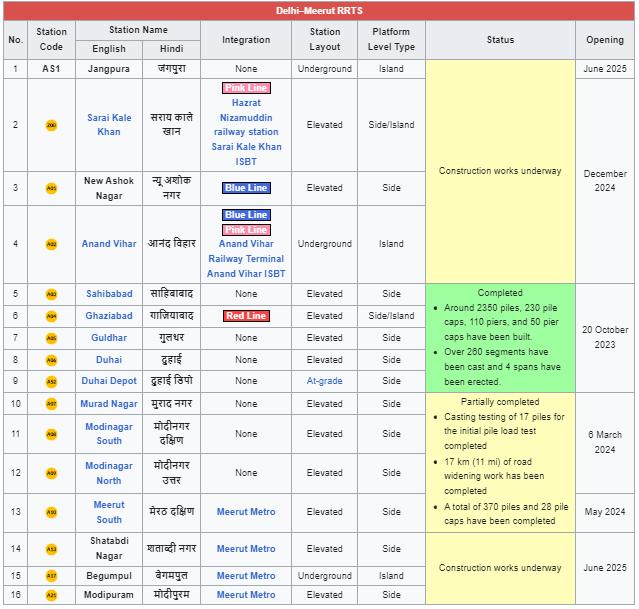 Delhi-Meerut RRTS Stations
Delhi-Meerut RRTS Stations
Image Source: Wikipedia
Delhi-Meerut RRTS: Fare Structure
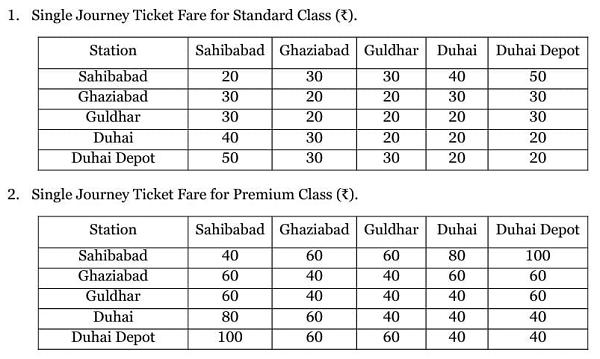 Delhi-Meerut RRTS Fare Structure
Delhi-Meerut RRTS Fare Structure
Image Source: The Metro Rail Guy
Delhi-Meerut RRTS: Features
The Delhi-Meerut RRTS stations are designed to offer passengers a world-class experience with advanced features and sustainable practices. Here are the key features:
Multi-Modal Transport Integration:
- Integration with various transport modes like metro stations, railway stations, inter-state bus terminals, cabs, and parking spaces.
- Seamless connectivity through skywalks, elevated walkways, and well-defined entry/exit points.
- The RRTS will operate alongside another rapid transit system in Meerut, marking a significant integration milestone in Indian transit history.
Safety Measures:
- Comprehensive surveillance with CCTVs and dedicated security staff to ensure passenger safety.
- Platform screen doors (PSDs) on platforms for enhanced safety and crowd management, a first in regional transit systems in India.
Sustainability Initiatives:
- Eco-friendly measures are implemented across stations to promote sustainability.
- Use of solar panels for electricity generation, waste disposal systems, water and sewage treatment facilities, and green spaces within station premises.
- Emphasis on cleanliness and waste management practices to create a healthy environment for passengers and staff.
- Shift towards public transport is expected to reduce daily vehicle circulations by over 100,000 and curb 300 tonnes of carbon dioxide emissions per day, contributing significantly to environmental sustainability and air quality improvement in the region.
Enhanced Passenger Experience:
- Modern amenities such as ticketing kiosks, information displays, seating areas, and retail spaces.
- Accessibility features for differently-abled passengers including ramps, elevators, and designated spaces.
- Wi-Fi connectivity, charging points, and digital displays for convenience and information dissemination.
- Passenger comfort amenities like clean washrooms, waiting areas, and dedicated facilities for children and senior citizens.
Efficiency and Operations:
- Automated systems for ticketing, baggage handling, and crowd management to ensure smooth operations.
- Real-time information updates, announcements, and emergency response systems for passenger convenience and safety.
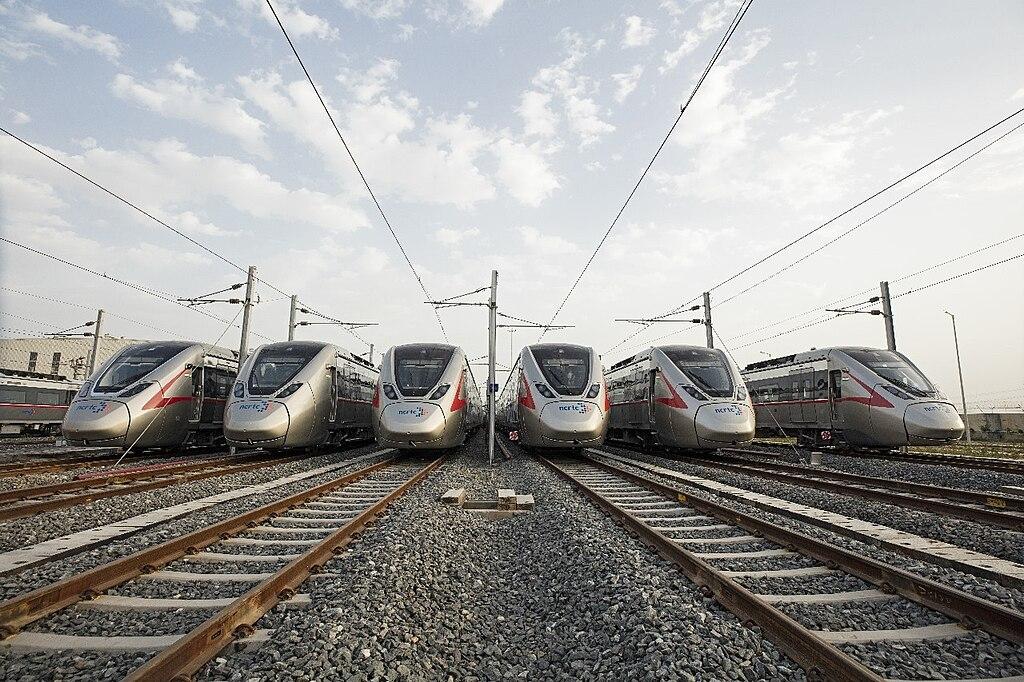 Namo Bharat Train Sets
Namo Bharat Train Sets
Image Source: Wikipedia
|
Feature |
Description |
|
Multi-Modal Integration |
Seamless connectivity with metro, rail, bus, and parking facilities through skywalks and entry points. |
|
Safety Measures |
CCTV surveillance, platform screen doors (PSDs), and dedicated security staff ensure passenger safety. |
|
Sustainability Initiatives |
Eco-friendly practices include solar panels, waste disposal, water treatment, and green spaces in stations. |
|
Enhanced Passenger Experience |
Modern amenities like ticket kiosks, Wi-Fi, seating areas, and accessibility features for a comfortable journey. |
|
Efficient Operations |
Automated systems for ticketing, crowd management, and real-time information ensure smooth station operations. |
Overall, the Delhi-Meerut RRTS stations are designed not just as transit points but as modern hubs that prioritize safety, sustainability, passenger comfort, and efficient operations, setting a benchmark for regional transit systems in India.
Delhi-Meerut RRTS: Facilities & Amenities
The Delhi-Meerut RRTS offers a range of facilities akin to those found at airports, ensuring a comfortable and convenient experience for travelers. These amenities include booking counters, ticket and food vending machines, on-board catering, washrooms, check-in kiosks, baggage checking counters, CCTVs, platform screen doors (PSDs), retiring rooms, restaurants, retail stores, free WiFi, child care facilities, and emergency and medical services. Special provisions are made for physically challenged passengers, such as wheelchair accessibility, escalators, elevators, and connectivity to other transport modes like Delhi Metro stations, inter-state bus terminals (ISBTs) of UPSRTC, Indian railway stations, Meerut Metro stations, cabs, auto-rickshaw stands, and parking spaces.
The National Capital Region Transport Corporation (NCRTC) introduced online booking facilities through the 'RRTS Connect' mobile app, offering a "one-tap ticketing" feature for Namo Bharat trains. This innovative feature allows commuters to generate a QR code swiftly within 300 meters of the RRTS station, simplifying ticketing and saving time and effort. This initiative, a first in India and globally, aligns with NCRTC's commitment to seamless and flexible travel experiences, allowing commuters to travel with spontaneity and adjust destinations during their journey.
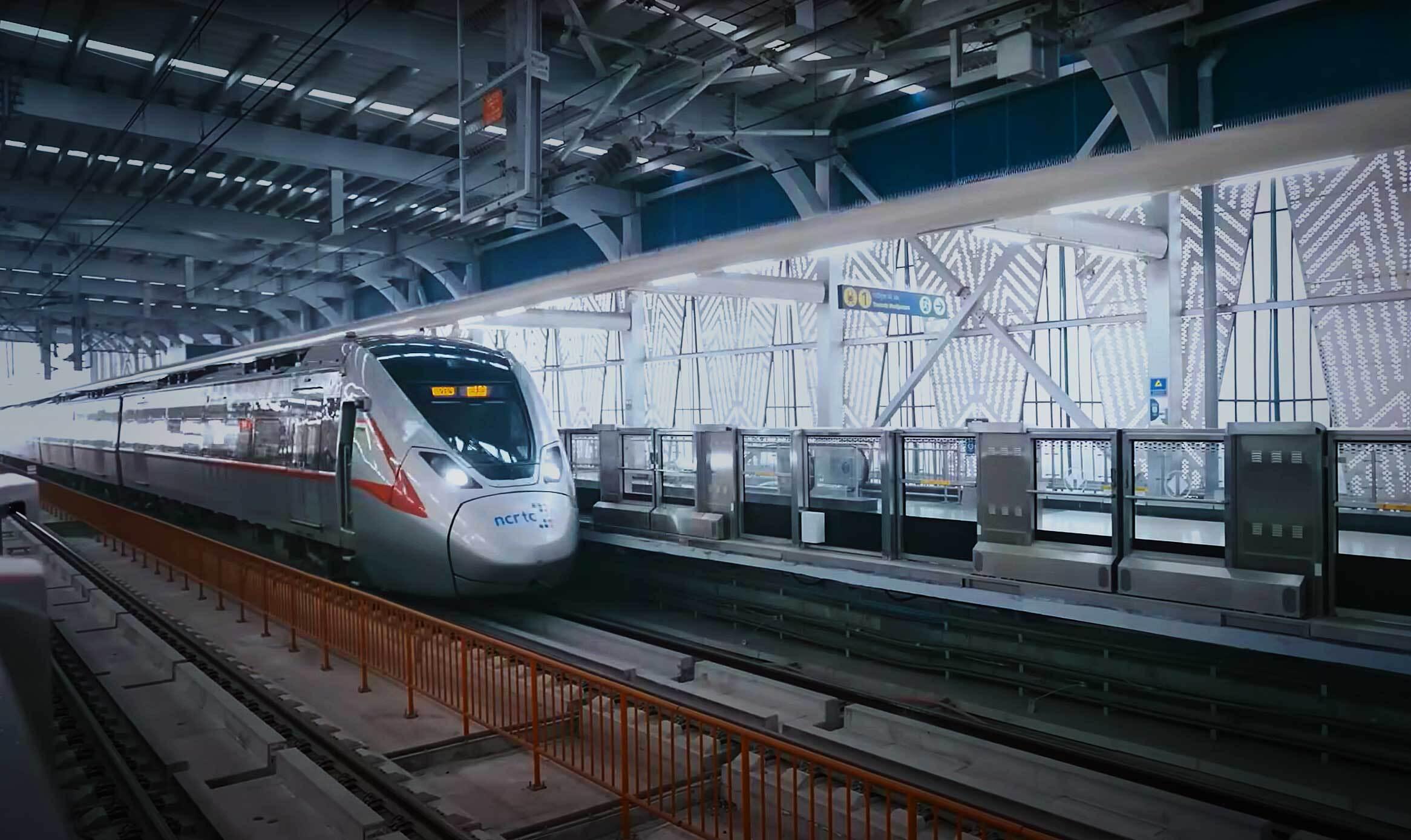 Delhi-Meerut RRTS
Delhi-Meerut RRTS
|
Facility/Amenity |
Description |
|
Booking Counters |
Counters for purchasing tickets and availing other services |
|
Ticket and Food Vending Machines |
Automated machines for ticket purchase and food/snack vending |
|
On-board Catering |
Food and beverage services available on trains |
|
Washrooms |
Facilities for personal hygiene |
|
Check-in Kiosks |
Kiosks for passenger check-in and related services |
|
Baggage Checking Counters |
Counters for checking and handling luggage |
|
CCTVs |
Surveillance cameras for security purposes |
|
Platform Screen Doors (PSDs) |
Automated doors for passenger safety and crowd control |
|
Retiring Rooms |
Rooms for resting or short stays |
|
Restaurants |
Dining facilities at stations or on trains |
|
Retail Stores |
Shops offering various goods and services |
|
Free WiFi |
Wireless internet connectivity for passengers |
|
Child Care Facilities |
Facilities for childcare |
|
Emergency and Medical Facilities |
Services for handling emergencies and providing medical aid |
|
Facilities for Physically Challenged Passengers |
Accessibility features such as wheelchairs, ramps, escalators, elevators |
|
Connecting Facilities |
Connectivity to other transport modes (e.g., Delhi Metro stations, ISBTs, Indian railway stations, Meerut Metro stations) |
|
Parking Spaces |
Parking areas for commuters' vehicles |
|
Online Booking |
Introduced through the 'RRTS Connect' app for ticket booking |
|
One-Tap Ticketing Feature |
Unique feature allowing commuters to generate QR codes swiftly within 300 meters of the RRTS station premises for ticketing purposes |
|
Spontaneous Travel |
Enables travelers to change destinations during the journey with flexibility |
Delhi-Meerut RRTS: Ridership Details
Following the commencement of operations on the 17 km (11 mi) stretch from Sahibabad to Duhai Depot in October 2023, the Delhi-Meerut RRTS initially recorded a ridership ranging between 2,500 and 3,000 passengers daily.
With the extension of the corridor by an additional 17 km (11 mi) from Duhai Depot to Modinagar North in March 2024, resulting in a total operational length of about 34 km (21 mi), the ridership has surged to approximately 12,000 passengers per day. This marks a substantial fivefold increase compared to the initial figures.
The anticipated growth is significant as the entire 82.15 km (51.05 mi) corridor from Sarai Kale Khan to Modipuram is projected to be operational by June 2025. It is expected that the ridership will escalate to an impressive 800,000 passengers per day upon the completion of the entire route.
|
Operational Phase |
Operational Length |
Ridership (Daily) |
|
Sahibabad to Duhai Depot (October 2023) |
17 km (11 mi) |
2,500 - 3,000 |
|
Duhai Depot to Modinagar North (March 2024) |
Additional 17 km (11 mi) |
Around 12,000 |
|
Entire Corridor (Projected by June 2025) |
82.15 km (51.05 mi) |
Expected: 800,000 |
Delhi-Meerut RRTS: Integration with Delhi Metro and Meerut Metro
|
Integration Point |
Connected Metro Lines/Stations |
Description |
|
Sarai Kale Khan |
Delhi Metro Pink Line |
Connects with Delhi Metro's Pink Line, providing interchange convenience for passengers traveling between the RRTS and the Pink Line. |
|
New Ashok Nagar |
Delhi Metro Blue Line |
Offers interchange with Delhi Metro's Blue Line, enhancing connectivity options for commuters transferring between the RRTS and the Blue Line. |
|
Anand Vihar |
Delhi Metro Pink Line, Blue Line |
Provides connectivity to both Delhi Metro's Pink Line and Blue Line, facilitating easy transfers for passengers moving between the RRTS and either of these lines. |
|
Ghaziabad |
Delhi Metro Red Line |
Interchange with Delhi Metro's Red Line at Ghaziabad, extending connectivity from the RRTS corridor till Modinagar North, allowing seamless travel for passengers between these two transit systems. |
|
Meerut South |
Meerut Metro |
Integration with Meerut Metro, offering seamless transfer opportunities for passengers traveling between the RRTS and the Meerut Metro, enhancing connectivity within Meerut and surrounding areas. |
|
Integrated Stations |
Modipuram, Begumpul, Shatabdi Nagar |
Integrated stations along the Meerut Metro line where passengers can transfer between the RRTS and Meerut Metro, providing ease of travel and connectivity within Meerut and facilitating access to Delhi-NCR regions. |
|
Modipuram Depot |
Delhi-Meerut RRTS, Meerut Metro |
Shared depot for both Delhi-Meerut RRTS and Meerut Metro trains, ensuring operational efficiency, maintenance, and coordination between the two transit systems. |
 Delhi Metro Yellow Line
Delhi Metro Yellow LineDelhi-Meerut RRTS: Expansion Plan Overview
On 26 January 2024, the National Capital Region Transport Corporation (NCRTC) outlined a future expansion plan for the RRTS corridor, aiming to extend it from its current endpoint in Meerut to Haridwar via Muzaffarnagar. This proposal was discussed during a meeting of the National Capital Region (NCR) planning board. NCRTC officials highlighted that if this plan is realized, the travel time between Delhi and Haridwar could reduce to just 2 hours, a significant improvement from the current 3-4 hours by road and 5-6 hours by rail.
To move forward with this ambitious extension, NCRTC officials have planned to conduct a comprehensive physical survey of the proposed section. This survey aims to assess the feasibility and practical execution of the project. Subsequently, a Detailed Project Report (DPR) will be prepared to delve deeper into the technical and logistical aspects of implementing the extended corridor.
How NCR's Transit System Took Shape
The task force formed by the Planning Commission in 2005, under the Chairmanship of the Secretary of the Ministry of Urban Development (MoUD), aimed to address the challenges posed by increasing population, traffic congestion, pollution, and the risk of accidents in the National Capital Region (NCR). This initiative was part of the Integrated Transport Plan for NCR 2032, with a specific focus on developing a multi-modal regional transit system, including the Regional Rapid Transit System (RRTS) to connect regional centers efficiently.
By 2013, recognizing the urgent need for a comprehensive regional railway system linking Delhi with adjoining cities and regions of the NCR and beyond, the Governments of India and Delhi collaborated to establish a strategic plan. This led to the formation of the National Capital Region Transport Corporation (NCRTC) in July 2013, as a joint venture involving the Governments of India and the states of Haryana, Rajasthan, Uttar Pradesh, and Delhi. The primary goal of NCRTC is to reduce reliance on road-based transportation, enhance regional connectivity within the NCR, and construct, own, and operate the Regional Rapid Transit Systems (RRTS).
The RRTS systems within Delhi are planned to predominantly operate underground, integrating seamlessly with the Delhi Metro to provide commuters with a faster last-mile connectivity solution. These systems are modeled after renowned regional transit systems worldwide such as London's Crossrail, Paris' RER, and Munich's S-Bahn.
Initially, eight corridors spanning at least 1,000 km (620 mi) were planned, and this has now expanded to nine corridors. Among these, four corridors are prioritized for implementation shortly: Delhi-Meerut, Delhi-Alwar, Delhi-Panipat, and Ghaziabad-Jewar. The Delhi-Meerut corridor took precedence due to the significant volume of travelers and traffic between Delhi and Meerut, leading to thorough studies and approvals from central, and state governments, and the NCRTC to commence its construction.
Conclusion
The Delhi-Meerut Regional Rapid Transit System (Delhi-Meerut RRTS) embodies a remarkable leap forward in India's transportation landscape, symbolizing innovation, efficiency, and connectivity. As a transformative initiative under the RapidX program, overseen by the National Capital Region Transport Corporation (NCRTC), the RRTS not only promises swift and seamless travel but also heralds a new era of sustainable and inclusive regional development.
With its cutting-edge semi-high-speed rail capabilities, the Delhi-Meerut RRTS is set to revolutionize commuting patterns, reducing travel time between key cities like Delhi, Ghaziabad, and Meerut to under 60 minutes. This significant enhancement in connectivity is poised to benefit millions of residents, commuters, and businesses, fostering economic growth and social cohesion across the National Capital Region (NCR).
The project's journey, from conceptualization to ongoing implementation, mirrors India's commitment to modernizing transit infrastructure and embracing global best practices in transportation. By integrating with existing metro systems, implementing advanced safety measures, and prioritizing sustainability through eco-friendly initiatives like solar power generation and water conservation, the RRTS sets a benchmark for future transit projects in the country.
As the RRTS expands its operational footprint and integrates seamlessly with the Delhi Metro and Meerut Metro, it not only facilitates efficient travel but also encourages a shift towards public transportation, reducing carbon emissions and alleviating congestion on roads. The project's expansion plans, including the proposed extension to Haridwar, further underscore its role as a catalyst for regional connectivity and economic progress.
To conclude, the Delhi-Meerut RRTS represents a transformative vision realized modern, efficient, and environmentally conscious transit system that paves the way for a sustainable and prosperous future for the National Capital Region and beyond.
explore further
Latest from Editorials
More from Publications
Resources
Dwello, for every home buyer, is a way to go from 'I feel' to 'I know', at no extra cost.




